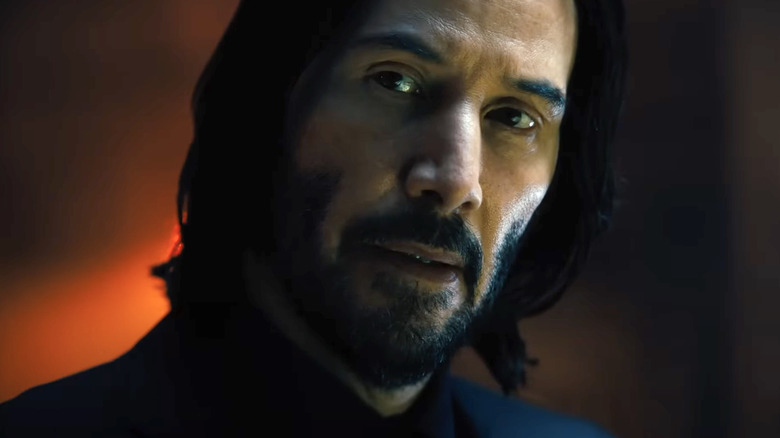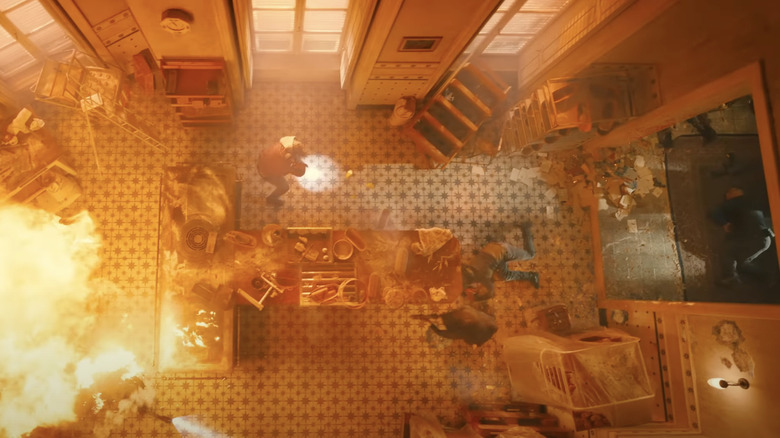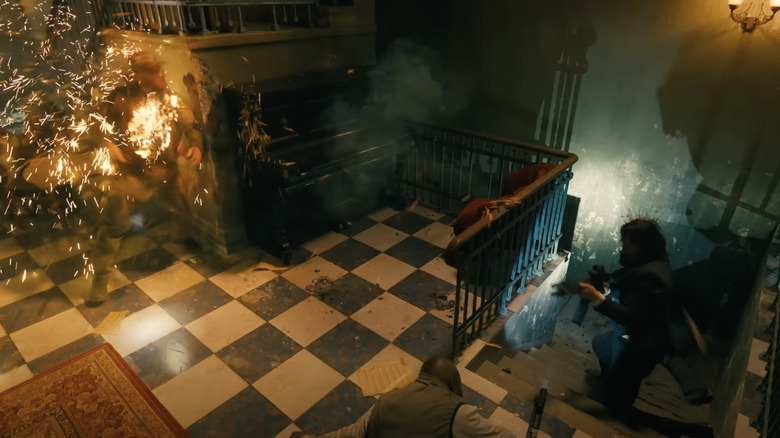John Wick: Chapter 4 Director Breaks Down That Fiery Top Shot Sequence [Exclusive Interview]
This post contains mild spoilers for "John Wick: Chapter 4."
If you've seen the fourth installment in the "John Wick" franchise, you know that Keanu Reeves ends up in multiple breathtaking places where he has to fight/kill multiple people in creative ways. There's more than one scene that will likely drill its way into our pop culture consciousness (or every time we walk up a set of really long stairs), and one of those is an overhead shot of Wick shooting and flamethrowing his way through an abandoned Parisian building.
The sequence is mesmerizing and like nothing we've seen on the big screen before. I spoke with "John Wick: Chapter 4" director Chad Stahelski before the movie's release, and during that discussion, I asked about how he and his team came up with the idea and then pulled it off. (/Film held this part of the conversation until the movie was released.) "You're always trying to be a little subversive," he told me, later adding that they "always look at things like, 'What's the problem? Let's give ourselves a really bad box and we'll fight our way out of it.' That's usually a cool way to figure something out."
That approach worked well for this sequence (as well as all the other sequences in the movie, for that matter). Read on for Stahelski's insights into the inspiration for the overhead shot and exactly how they stitched it all together.
Note: This interview has been lightly edited for clarity and brevity.
'If you're ever lacking creativity, handcuff yourself and then figure it out'
One sequence I thought was really impressive was in the abandoned building in France with the overhead shot of the fight. I would love to hear about how you came up with the idea for it and technically how you pulled it off. How much of that was a single shot?
To be brutally honest, there's two stitches in the first take. There's a cutaway, obviously, when you go back down, but we did get it so the whole sequence would've been done with three stitches. A stitch is a digital overlay where it looks like it's one.
The first one is quite long, which we're very proud of. It spirals, we call it a candy cane. It comes up from John Wick, it goes into the kitchen, the guy gets lit on fire and then we have a small digital stitch, then we go all the way through the other shot. We had done the entire top shot sequence in four main chunks in three stitches. So that's how that really worked.
The idea came from, again, you're always trying to be a little subversive, and lighting for us is a big deal. No one does top shots because you look at the ground and it's not very interesting. We always look at things like, "What's the problem? Let's give ourselves a really bad box and we'll fight our way out of it." That's usually a cool way to figure something out.
If you're ever lacking creativity, handcuff yourself and then figure it out, because then you'll do something you haven't done before. So top shots were never very cool with us, with lighting or choreography, because it gets old quick. But I had seen this video game and I'll throw a shout-out — I think it was called "Hong Kong Massacre" — they did this top shot and we had been doing so much with the big muzzle flashes and it just kind of clicked like, "Well, if I'm above, we shoot like this and we shoot like this, and it draws these cool lines with the muzzle flash, and if I get the right flicker effect, it's like Etch A Sketch. It looks really cool." And it was a different way to amp up the action and keep you in that video game mode that John Wick's kind of known for, that first-person shooter kind of thing.
'It's the same kind of cameras that you had at the Super Bowl'
So between that, and I talked to Dan Laustsen and Kevin Kavanaugh, my cinematographer and production designer, going, "Oh, we think we can do something cool with this. Let's design a cool zigzag pattern. And what we'll do is we'll have this gun — it's a Genesis 12 shotgun that shoots this phosphorus ammunition called Dragon's Breath, which looks like it's a flamethrower — and if we do that with the debris, we could create these really interesting configurations from the top shot." We were just thinking, "What would be cool?" Then we started doing tests and we were like, "Oh, this could be really cool. We should figure this out."
Then between figuring out the camera position — it's called the four-point flying system where it's on these control winches and the camera's suspended between four wires — we adjust so we can do a very odd motion. It's the same kind of cameras that you had at the Super Bowl. We took that system and put it inside a sound stage. And then the real burden came to Keanu when we told him, "You got to come up the stairs, switch guns, do all this stuff on, guys are going to be on fire, falling off the staircase, you're going to come through here, and you only have to know about a hundred moves. And try not to screw up, because we only have three days."
Oh wow. Three days. Wow.
That entire scene, everything in that set-piece was done in three days.
"John Wick: Chapter 4" is now playing in theaters.


